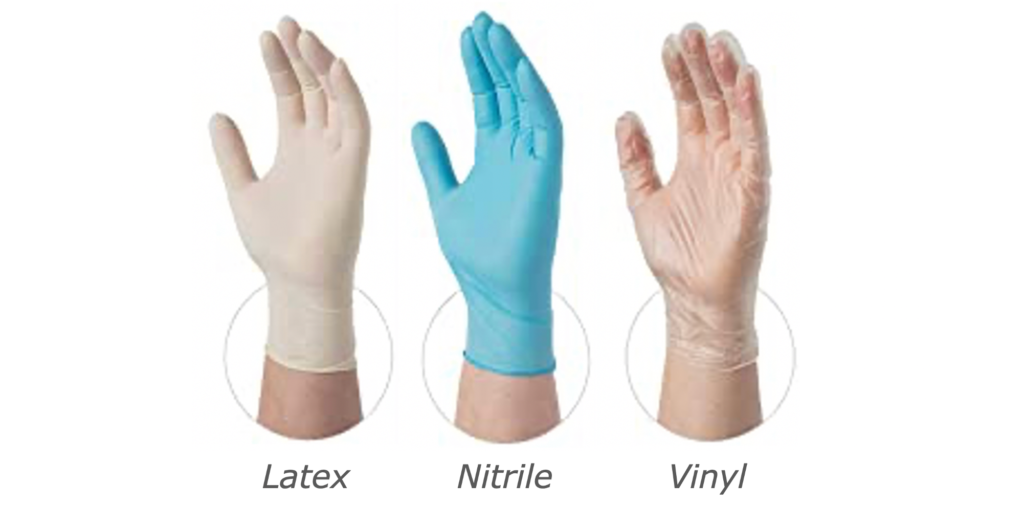Gloves can be one of the most expensive items in your supply budget, and with the current scarcity of nitrile supply, you need to be sure you are purchasing gloves suitable to your use. Finding a reliable partner who can help guide you toward a cost-effective strategy of securing your supply is imperative.
We currently have the following blends ready to ship immediately: Synmax Vinyl/Nitrile Hybrid Exam Grade, Hongray Vinyl/Nitrile Blend, ICU Vinyl/Nitrile Blend, Wally Plastic Nitrile/Vinyl Blend and MedCare Nitra Force Synthetic Nitrile Exam Grade.
Complete the form to request more information about our gloves, or to schedule your evaluation today!
GLOVE GUIDE: MATERIALS
Gloves are made from many different materials. With both natural and synthetic materials, there is a glove type that will be right for your organization:
- Latex gloves are made of a natural material from the bark of rubber trees and feature a “second skin” fit, heightened sensitivity and effective barrier protection.
- Nitrile gloves are made of a synthetic rubber material that is a great alternative to latex if allergies are a concern. Nitrile has a high resistance to harsh chemicals, a long shelf life and excellent puncture resistance.
- Vinyl gloves are a lightweight synthetic made from PVC (polyvinyl chloride). Vinyl gloves are commonly used in the food service industry and for light-duty tasks where high levels of durability and basic protection are the priority.

GLOVE GUIDE: Types
- Medical gloves are disposable and include exam gloves, surgical gloves and chemotherapy gloves. These gloves are regulated by the Food and Drug Administration (FDA) and are reviewed to ensure leak resistance, tear resistance and biocompatibility standards are met.
- Surgical gloves have more precise sizing with better sensitivity.
- Examination gloves are available as either sterile or non-sterile versions and meet the ASTM D6319 standard.
- Chemo exam gloves are designed specifically to prevent negative reactions from exposure to cytotoxic drugs.
- Non-Medical gloves are designed for other industries and are not required to meet the ASTM D6319 standard. These gloves are used in food services, industrial, transportation, janitorial and other non-medical environments.

GLOVE GUIDE: KEY CHARACTERISTICS
When it comes to gloves, there are certain product features we need to pay attention to:
- Elasticity – Latex is the most elastic with Nitrile in the middle and Vinyl being the least elastic. Also, Nitrile is the most puncture resistant.
- Chemical Resistance – Nitrile is the most chemical resistant, followed by Latex, and Vinyl is the least resistant.
- Thickness – Measured in mil (0.001 of an inch), thickness is measured at the palm and the fingertips of the gloves.
- Texture – To enhance tactile feel, gloves often do not have any texture, however some glove types have an additional texture added to enhance grip.
- Powder free – Exam gloves are required to be powder free, and powdered gloves were banned by the US FDA in December 2016.
GLOVE GUIDE: GRADES
There are three primary types of glove grades:
- Medical Grade – All medical grade gloves have been tested by the Food and Drug Administration to ensure their durability.
- ASTM D6319 is the standard specification for Nitrile Exam gloves for medical applications.
- ASTM D6978 is the standard for Assessment of Resistance of Medical Gloves to Permeation by Chemotherapy drugs.
- Industrial Grade – Designed to stand up to harsher chemicals, these gloves feature durability and are ideal for delivery, janitorial or heavier duty food tasks.
- Food Service Grade – Designed to fulfill a variety of tasks and are approved for food prep and other light duty tasks.